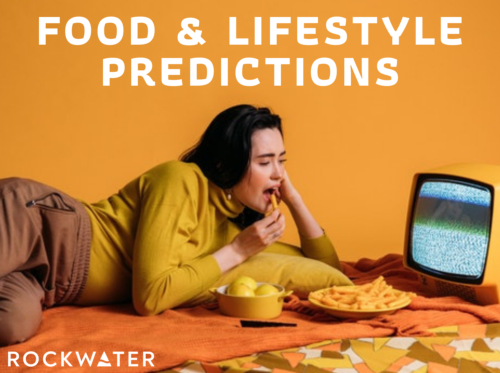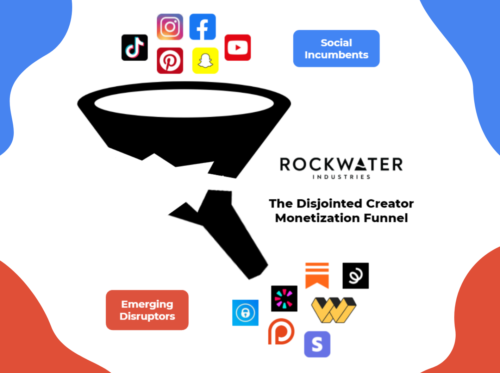Why MrBeast Burger Will (Not) Kill Legacy CPG, Celeb Food App Flavrs Raises $7M from A16Z, and Is BeReal the Next Clubhouse?
What We’re Reading
3 articles + RockWater analysis to make you a better investor and operator.
———
Why did 10,000 People Show Up to Buy a MrBeast Burger?
Mashable 9.6.2022
The RockWater Take by Chris Erwin
Will McDonald’s lose out as world’s #1 burger brand to MrBeast Burger in next 20 years?
…part of increasing debate about why creators will beat out every legacy CPG brand by 2040.
Some of my takes 👇👇 as a thought exercise.
Net net, I see large disruption ahead. But not at scale many pontificating. Never underestimate incumbents, who have great resources and have strong incentive to the status quo.
—
WHY LEGACY CPG WILL DIE BY 2040
Content is the new universal truth for mktg goods and services. New creator class is best at it. Skill gap between creators and legacy brands is widening. Then CPG goes by wayside as their CAC goes through roof relative to creator-led businesses.
Also, CPG products are not differentiated. All about branding, marketing, distribution. Now anyone can develop and launch a CPG product quickly and w/ minimal resources (e.g. Spring, Popchew). And acknowleding this is very different than sophisticated and time-consuming product dev cycles like hardware, automotive, etc.
COUNTERPOINT…
Legacy CPG has big pockets and will buy / build / partner into content differentiation.
Much M&A in content x commerce already, see Coty / Kylie Cosmetics, Unilever / Dollar Shave Club, Hasbro / Entertainment One, PENN Entertainment, Inc / Barstool Sports = tip of iceberg.
Growth in “recommendation media” will reduce creator’s audience reach, lead to creator commoditization. Will grow the micro creator class, and platforms like GRIN, Tagger, Pearpop will give well-resourced CPG brands a powerful partnership strategy to win in new algo world. And CPG brands will strike partnerships with platforms for guaranteed featured placement, cause they have the budget to do so.
Product quality matters. But even moreso, as we’ve proven during COVID, are that supply chains are the new battleground frontier for customer delight. Getting massive amounts of product into hands of consumers, quickly and efficiently, backed by incredible customer service, is a billion-dollar investment. See recent Amazon / Walmart / Shopify investments, and why incumbent retailers stood strong as so many subscale DTC brands suffered over past couple years.
Now, could many DTC brands start to piggy back of infrastructure from retailers? Yes. But that’s not all you need when compared to systems and logistics development from big CPG like Procter & Gamble, L’Oréal….unless Amazon starts offering XX-as-a-service for every stage in CPG cycle…and then Amazon wins the world 😉
Yup, a good discussion to have so we can all be better in bringing new products and biz models into the world!
———
A16Z Backs the Launch of Shoppable Video App Flavrs with $7M Seed Funding
Forbes, 9.13.2022
The RockWater Take by Alex Zirin
Flavrs, a shoppable video app that combines premium celebrity food content and commerce launched earlier this week following the completion of a $7M seed round led by A16Z. In addition to a host of other venture funds (Wellington Access Ventures, Cercano Management, Progression Fund, and firstminute Capital), culinary legends Tom Colicchio (Top Chef) and Eric Ripert have taken a seat at the cap table.
Founded by former Googlers, Flavrs brings food content and ingredient shopping under one digital roof. Hungry home cooks can discover chef-driven recipes within the app and immediately shop for ingredients via an Instacart integration.
Flavrs’ goal is to “give you the most efficient, most satisfying way to go from intention to action.” This notion is significant if executed effectively. Hunger can be a powerful, raw remotion. Often, powerful emotions have the ability to influence our behavior. In this case, as we wrote about with the launch of Goldbelly TV late last year, that behavior is purchase conversion.
As content and commerce continue to converge, a large question looms over launches like Flavrs, Goldbelly TV, Flip, and more…
Is the digital content ecosystem / creator economy built to support a very large number of distributed platforms, segmented by content vertical?
Seemingly, VC feels that it can. However, in my view, we’re headed for similar consolidation to that seen in the streaming wars.
While apps like Flavrs and Flip are likely better built for their specific type of content than the generalist platforms that dominate the space, the competition for eyeballs online is as stiff as ever.
For all food lovers, continued investment in the digital food space is exciting, especially in the current capital environment. However, in today’s attention economy, this battle is certainly an uphill one.
———
TikTok Just Launched a BeReal Clone Called TikTok Now
TechCrunch, 9.15.2022
The RockWater Take by Mike Booth:
There’s been so much recent chatter about BeReal that I downloaded the app and have been using it daily. I have a few observations about what is going right and where the platform’s future is headed. 👇🏼👇🏼👇🏼
What’s Going Right:
1) Product / market fit – there’s a large swath of millennials / gen z that are jaded with Instagram culture. Logging into BeReal feels cathartic. No glitz and glam, just mundane photos of your friends living their daily life. The platform has created a depressurized atmosphere that feels much more healthy than other social networks. I genuinely enjoy my time spent on the app, seeing what my friends are up to VS going on IG and wondering why my life feels so boring compared to everyone else!
2) Post-to-View UGC –BeReal users have to post their daily photo before they’re able to view any of their friends’ content. As a challenger platform, reaching a critical mass of content creation is paramount. However, the issue for platforms is that most of the users they acquire post little (if any) content. By utilizing post-to-view BeReal requires far less users to reach the same content output as their competitors.
3) Concurrent User Activity – BeReal’s daily posting prompt is announced via push notifications at a randomized time each day. Every user gets on the app at the drop of the hat and posts their photo. User-to-user engagement during these windows is really high; excitement is in the air!
Where Does it Go From Here:
While I like the product, I see a challenging road ahead.
1) Classic question – is it a product or a feature? Feature. At the end of the day, BeReal is a content format that has been mapped on top of a social graph. Incumbent platforms have a much easier time replicating new content formats than they do replicating network structures. This is why IG can rip the story content format from Snap, but struggles to replicate the recommendation media network structure of TikTok. The former requires a content integration into an existing distribution structure, whereas the latter requires re-engineering the entire distribution structure altogether. IG, Snap, and TikTok have already started rolling out BeReal clones which I expect will see some success
2) How does BeReal scale mass market? I suspect mass user scale would corrode its authentic look and feel, becoming IG lite. The platform also isn’t yet monetized; presumably it will roll out advertisements eventually, but again that feels antithetical to the environment BeReal has cultivated.
If I had to bet, I think BeReal solidifies itself as a niche alternative platform with a dedicated following, but struggles to grow beyond that. Remember Clubhouse?
———
If these insights are relevant to projects you are thinking through, ping us here. We’re always excited to riff through ideas!



